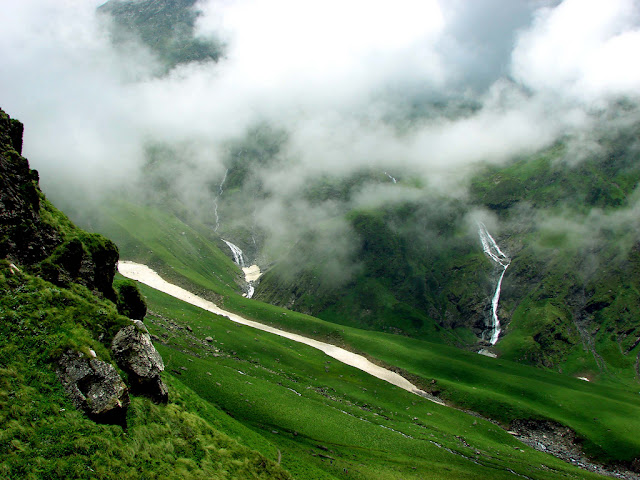Himachal Pradesh is great place for trekking in Himalayas. Himachal literally means ‘ The lap of Himalaya or The Land of snowy mountains’ The state of Himachal Pradesh is placed within the mountain chain of the Himalayas, bounded in the north by Tibet, North West by the state of Jammu & Kashmir, its south lie the plains of the Punjab and the east is bounded by the Garhwal Himalaya. This region of this part of Himalaya is also known as the western Himalaya. The western Himalayan region supports a great diversity of flora & fauna.
 |
| Spiti is known for the most sought after Chandratal Trek in Himachal |
From the lofty pines and spruces and the great to the dense cushions and prostrate branches of the alpine herbs and junipers and from Sub alpine zone of birches, stunted firs and rhododendron bushes to semi arid terrains of Spiti, Himachal Pradesh has so much to offer in term of travel experience.
Trekking is all about enjoying a great walking holidays. Trekking is not a risky affair as far as your health is concerned. But a person should be reasonably fit for this activity. Trekking routes are graded on levels of difficulty.
From trekking point of view, the territory of Himachal Pradesh can be divided into another three zones of Himalaya
The outer Himalayas (from 350 mts to 1500 mts) also known Shivalik hills It covers the lower hills of district Kangra, Hamirpur, Una, Bilaspur and lower parts of Mandi, Solan and Sirmaur districts. The annual rainfall in this zone varies from 1500 mm to 1800 mm. The climate and soil of this zone is suitable for the cultivation of maize, wheat, sugarcane, ginger, citrus fruits and table potatoes.
The inner Himalayas (from 1500 mts to 4500 mts) Dhauladhar & Pir Panjal ranges. Pir-Panjal is the largest range of the lower Himalayas and it separates itself from the Himalayas near the bank of Satluj River, it makes a water-divide between the rivers Beas and Ravi on the one side and the river Chenab on the other side. Pir Panjal range makes a turn towards the Dhauladhar range near Bara-Banghal that is the source of the river Ravi. Areas in this zone upper areas of District Sirmour, Mandi , Kangra , Palampur, Shimla and upper parts of Chamba district
The greater Himalayas (from 4500mts to highest points of the great Himalayas) The Great Himalayan range rivers along the Eastern boundary. The Satluj river divides it and separates the Spiti's (Lahaul-Spiti) drainage from Beas. Area in this zone are district Kinnaur, Chamba district and some areas of Lahaul and Spiti. The normal rainfall in this zone is low. This part of Himalaya is also known as The Trans Himalaya. The famous Zanskar Range acts like a big wall by separating Spiti and Kinnaur from Tibet. Zanskar Range has a number of very high peak points rising over 6,500 meters The highest among its peaks is Shilla which is 7,025 meters high. The second one is Liyo Phargyul which is 6,791 meters high.
Weather Conditions:
March to April weather remains pleasant in entire Himachal. May and June are summer period and the lower Himalaya would be hot during the summer. July & August are the monsoon period and there can be rains around during this period
Jan–Feb
Lower Himalaya - Cold with possibility of snow in upper part
Upper Himalaya - Peak winter & snow fall
Trans Himalaya - Freezing winter & remains closed during this period
Feb- Mar
Lower Himalaya - Pleasant with some rain
Upper Himalaya Cold with possibility of snow in upper part
Trans Himalaya - Peak winter & snow fall & remains closed during this period
Mar- Apr
Lower Himalaya - Pleasant with chances of rain
Upper Himalaya pleasant with some rain
Trans Himalaya - Pleasant during the day nights & morning can be little cold & but snow in high mountain passes & remains closed during this period
Apr- May
Lower Himalaya - No rain, clear skies & little Hot
Upper Himalaya - Pleasant with clear sky
Trans Himalaya - Pleasant with clear sky chances of snow in high mountains
May-June
Lower Himalaya - Hot & Dry
Upper Himalaya - clear skies & little Hot
Trans Himalaya - Hot & Dry during the day and nights & morning can be little cold in this sector starts operation after June 1st week
June–July
Lower Himalaya - Hot till June end , pre-monsoon rain Hot and dry
Upper Himalaya - little Hot and rainy
Trans Himalaya - Hot & Dry during the day and nights & morning can be little cold
July– Aug
Lower Himalaya - Hot and rainy (Monsoon period )
Upper Himalaya - Rainy(Monsoon period)
Trans Himalaya - clear skies & little Hot and nights & morning can be little cold
Aug- Sep
Lower Himalaya - Rainy till Aug - dry predominantly rainy season
Upper Himalaya - Rainy & chances of snow in high mountain passes
Trans Himalaya - Winter starts setting after 15 September and chances of snow fall
Sep -Nov
Lower Himalaya - Mostly clear shorter days , morning & nights can be little cold
Upper Himalaya - Cold & dry winter starts setting and chances of snow fall in high mountains
Trans Himalaya - Winter and chances of heavy snow fall not recommendable for travelers after September
Nov- Dec
Lower Himalaya - starting of winter, dry & cold
Upper Himalaya - Very cold and chances of snow fall
Trans Himalaya - Peak winter - freezing cold
Dec – Jan
Lower Himalaya - Cold with rain & snow in upper part. Very little snow
Upper Himalaya - Peak winter – chances of heavy snow fall – nights & morning can be freezing cold
Trans Himalaya - Peak winter - freezing cold
More information on Himachal Pradesh Travel and Tourism: www.himachalpradeshindia.com













0 comments:
Post a Comment
Its always nice to hear your feedback. It doesn't matters if its the bouquet or the brickbats, we welcome your honest opinion :-) Please drop a word!